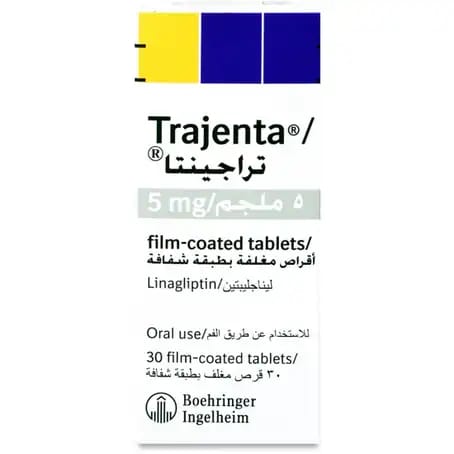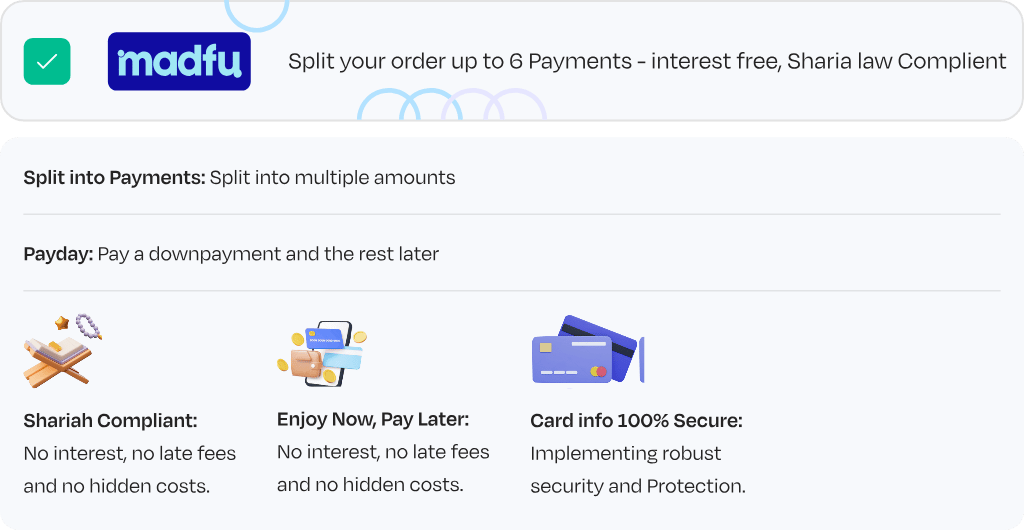Linagliptin 5mg tablets
What Linagliptin is used for:
Linagliptin is used for ‘type 2 diabetes’ in adults, if the disease cannot be adequately controlled with one oral anti-diabetic medicine (metformin or sulphonylureas) or diet and exercise alone. Linagliptin may be used together with other anti-diabetic medicines e.g. metformin, sulphonylureas (e.g. glimepiride, glipizide), empagliflozin, or insulin.
Do not take Linagliptin :
If you are allergic to linagliptin or any of the other ingredients of this medicine.
Warnings and precautions:
Talk to your doctor or pharmacist before taking Linagliptin acid if you:
have type 1 diabetes (your body does not produce any insulin) or diabetic ketoacidosis (a
complication of diabetes with high blood sugar, rapid weight loss, nausea or vomiting).
are taking an anti-diabetic medicine known as a ‘sulphonylurea’ (e.g. glimepiride, glipizide),
your doctor may want to reduce your dose of sulphonylurea when you take it together with
Linagliptin in order to avoid your blood sugar going too low.
have had allergic reactions to any other medicines that you take to control the amount of sugar in your blood.
have or have had a disease of the pancreas.
Linagliptin is not recommended for children and adolescents under 18 years.
Possible side effects :
These include allergic symptoms of low blood sugar: trembling, sweating, anxiety, blurred vision, tingling lips, paleness, mood change or confusion (hypoglycemia).
Some patients have experienced allergic reactions while taking Linagliptin alone or in combination with other medicinal products for the treatment of diabetes, which may be serious, including wheezing and shortness of breath. Some patients experienced rash, hives (urticaria), and swelling of the face, lips, tongue, and throat that may cause difficulty in breathing or swallowing (angioedema). Some patients have experienced inflammation of the pancreas (pancreatitis) while taking Linagliptin alone or in combination with other medicinal products for the treatment of diabetes.
Other medicines and Linagliptin :
Tell your doctor or pharmacist:
Taking carbamazepine, phenobarbital or phenytoin. These may be used to control fits (seizures) or
chronic pain.
Taking rifampicin. This is an antibiotic used to treat infections such as tuberculosis.
6016- Home
- Medications
- Medication
- Trajenta 5 mg 30 Tablets
Trajenta 5 mg 30 Tablets
 113.4
113.4Loyalty Program
Loyalty
For each qualifying purchase you make, you will accumulate loyalty points. These points can then be redeemed for a variety of rewards such as discounts, exclusive, offers or even free products.
For Each
100
SAR
-->
100
POINTS
TIER2
100
SPAR SPEND
=
100
POINTS
TIER3
100
SPAR SPEND
=
100
POINTS
- Details
Linagliptin 5mg tablets
What Linagliptin is used for:
Linagliptin is used for ‘type 2 diabetes’ in adults, if the disease cannot be adequately controlled with one oral anti-diabetic medicine (metformin or sulphonylureas) or diet and exercise alone. Linagliptin may be used together with other anti-diabetic medicines e.g. metformin, sulphonylureas (e.g. glimepiride, glipizide), empagliflozin, or insulin.
Do not take Linagliptin :
If you are allergic to linagliptin or any of the other ingredients of this medicine.
Warnings and precautions:
Talk to your doctor or pharmacist before taking Linagliptin acid if you:
have type 1 diabetes (your body does not produce any insulin) or diabetic ketoacidosis (a
complication of diabetes with high blood sugar, rapid weight loss, nausea or vomiting).
are taking an anti-diabetic medicine known as a ‘sulphonylurea’ (e.g. glimepiride, glipizide),
your doctor may want to reduce your dose of sulphonylurea when you take it together with
Linagliptin in order to avoid your blood sugar going too low.
have had allergic reactions to any other medicines that you take to control the amount of sugar in your blood.
have or have had a disease of the pancreas.
Linagliptin is not recommended for children and adolescents under 18 years.
Possible side effects :
These include allergic symptoms of low blood sugar: trembling, sweating, anxiety, blurred vision, tingling lips, paleness, mood change or confusion (hypoglycemia).
Some patients have experienced allergic reactions while taking Linagliptin alone or in combination with other medicinal products for the treatment of diabetes, which may be serious, including wheezing and shortness of breath. Some patients experienced rash, hives (urticaria), and swelling of the face, lips, tongue, and throat that may cause difficulty in breathing or swallowing (angioedema). Some patients have experienced inflammation of the pancreas (pancreatitis) while taking Linagliptin alone or in combination with other medicinal products for the treatment of diabetes.
Other medicines and Linagliptin :
Tell your doctor or pharmacist:
Taking carbamazepine, phenobarbital or phenytoin. These may be used to control fits (seizures) or
chronic pain.
Taking rifampicin. This is an antibiotic used to treat infections such as tuberculosis.
Linagliptin 5mg tablets
What Linagliptin is used for:
Linagliptin is used for ‘type 2 diabetes’ in adults, if the disease cannot be adequately controlled with one oral anti-diabetic medicine (metformin or sulphonylureas) or diet and exercise alone. Linagliptin may be used together with other anti-diabetic medicines e.g. metformin, sulphonylureas (e.g. glimepiride, glipizide), empagliflozin, or insulin.
Do not take Linagliptin :
If you are allergic to linagliptin or any of the other ingredients of this medicine.
Warnings and precautions:
Talk to your doctor or pharmacist before taking Linagliptin acid if you:
have type 1 diabetes (your body does not produce any insulin) or diabetic ketoacidosis (a
complication of diabetes with high blood sugar, rapid weight loss, nausea or vomiting).
are taking an anti-diabetic medicine known as a ‘sulphonylurea’ (e.g. glimepiride, glipizide),
your doctor may want to reduce your dose of sulphonylurea when you take it together with
Linagliptin in order to avoid your blood sugar going too low.
have had allergic reactions to any other medicines that you take to control the amount of sugar in your blood.
have or have had a disease of the pancreas.
Linagliptin is not recommended for children and adolescents under 18 years.
Possible side effects :
These include allergic symptoms of low blood sugar: trembling, sweating, anxiety, blurred vision, tingling lips, paleness, mood change or confusion (hypoglycemia).
Some patients have experienced allergic reactions while taking Linagliptin alone or in combination with other medicinal products for the treatment of diabetes, which may be serious, including wheezing and shortness of breath. Some patients experienced rash, hives (urticaria), and swelling of the face, lips, tongue, and throat that may cause difficulty in breathing or swallowing (angioedema). Some patients have experienced inflammation of the pancreas (pancreatitis) while taking Linagliptin alone or in combination with other medicinal products for the treatment of diabetes.
Other medicines and Linagliptin :
Tell your doctor or pharmacist:
Taking carbamazepine, phenobarbital or phenytoin. These may be used to control fits (seizures) or
chronic pain.
Taking rifampicin. This is an antibiotic used to treat infections such as tuberculosis.
How to take Linagliptin:
The recommended dose of Linagliptin is one 5 mg tablet once a day.
You can take Linagliptin with or without food.
Your doctor may prescribe Linagliptin together with another oral anti-diabetic medicine. Remember to take all medicines as directed by your doctor to achieve the best results for your health.
Linagliptin 5mg tablets
What Linagliptin is used for:
Linagliptin is used for ‘type 2 diabetes’ in adults, if the disease cannot be adequately controlled with one oral anti-diabetic medicine (metformin or sulphonylureas) or diet and exercise alone. Linagliptin may be used together with other anti-diabetic medicines e.g. metformin, sulphonylureas (e.g. glimepiride, glipizide), empagliflozin, or insulin.
Do not take Linagliptin :
If you are allergic to linagliptin or any of the other ingredients of this medicine.
Warnings and precautions:
Talk to your doctor or pharmacist before taking Linagliptin acid if you:
have type 1 diabetes (your body does not produce any insulin) or diabetic ketoacidosis (a
complication of diabetes with high blood sugar, rapid weight loss, nausea or vomiting).
are taking an anti-diabetic medicine known as a ‘sulphonylurea’ (e.g. glimepiride, glipizide),
your doctor may want to reduce your dose of sulphonylurea when you take it together with
Linagliptin in order to avoid your blood sugar going too low.
have had allergic reactions to any other medicines that you take to control the amount of sugar in your blood.
have or have had a disease of the pancreas.
Linagliptin is not recommended for children and adolescents under 18 years.
Possible side effects :
These include allergic symptoms of low blood sugar: trembling, sweating, anxiety, blurred vision, tingling lips, paleness, mood change or confusion (hypoglycemia).
Some patients have experienced allergic reactions while taking Linagliptin alone or in combination with other medicinal products for the treatment of diabetes, which may be serious, including wheezing and shortness of breath. Some patients experienced rash, hives (urticaria), and swelling of the face, lips, tongue, and throat that may cause difficulty in breathing or swallowing (angioedema). Some patients have experienced inflammation of the pancreas (pancreatitis) while taking Linagliptin alone or in combination with other medicinal products for the treatment of diabetes.
Other medicines and Linagliptin :
Tell your doctor or pharmacist:
Taking carbamazepine, phenobarbital or phenytoin. These may be used to control fits (seizures) or
chronic pain.
Taking rifampicin. This is an antibiotic used to treat infections such as tuberculosis.
How to take Linagliptin:
The recommended dose of Linagliptin is one 5 mg tablet once a day.
You can take Linagliptin with or without food.
Your doctor may prescribe Linagliptin together with another oral anti-diabetic medicine. Remember to take all medicines as directed by your doctor to achieve the best results for your health.
Linagliptin 5mg tablets
What Linagliptin is used for:
Linagliptin is used for ‘type 2 diabetes’ in adults, if the disease cannot be adequately controlled with one oral anti-diabetic medicine (metformin or sulphonylureas) or diet and exercise alone. Linagliptin may be used together with other anti-diabetic medicines e.g. metformin, sulphonylureas (e.g. glimepiride, glipizide), empagliflozin, or insulin.
Do not take Linagliptin :
If you are allergic to linagliptin or any of the other ingredients of this medicine.
Warnings and precautions:
Talk to your doctor or pharmacist before taking Linagliptin acid if you:
have type 1 diabetes (your body does not produce any insulin) or diabetic ketoacidosis (a
complication of diabetes with high blood sugar, rapid weight loss, nausea or vomiting).
are taking an anti-diabetic medicine known as a ‘sulphonylurea’ (e.g. glimepiride, glipizide),
your doctor may want to reduce your dose of sulphonylurea when you take it together with
Linagliptin in order to avoid your blood sugar going too low.
have had allergic reactions to any other medicines that you take to control the amount of sugar in your blood.
have or have had a disease of the pancreas.
Linagliptin is not recommended for children and adolescents under 18 years.
Possible side effects :
These include allergic symptoms of low blood sugar: trembling, sweating, anxiety, blurred vision, tingling lips, paleness, mood change or confusion (hypoglycemia).
Some patients have experienced allergic reactions while taking Linagliptin alone or in combination with other medicinal products for the treatment of diabetes, which may be serious, including wheezing and shortness of breath. Some patients experienced rash, hives (urticaria), and swelling of the face, lips, tongue, and throat that may cause difficulty in breathing or swallowing (angioedema). Some patients have experienced inflammation of the pancreas (pancreatitis) while taking Linagliptin alone or in combination with other medicinal products for the treatment of diabetes.
Other medicines and Linagliptin :
Tell your doctor or pharmacist:
Taking carbamazepine, phenobarbital or phenytoin. These may be used to control fits (seizures) or
chronic pain.
Taking rifampicin. This is an antibiotic used to treat infections such as tuberculosis.
How to take Linagliptin:
The recommended dose of Linagliptin is one 5 mg tablet once a day.
You can take Linagliptin with or without food.
Your doctor may prescribe Linagliptin together with another oral anti-diabetic medicine. Remember to take all medicines as directed by your doctor to achieve the best results for your health.

















